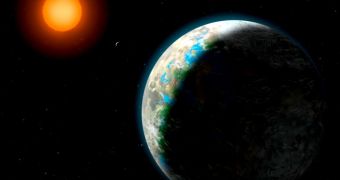In a new astronomical study conducted to validate a discovery announced in late 2010, experts could not find any signs that the proposed exoplanet dubbed Second Earth actually orbits its alleged parent star, Gliese 581.
That is not to say that no exoplanets were found around the object. That system is known for housing several planets, each of them orbiting at various distances from the central star.
What the new study failed to detect was any extrasolar planet orbiting Gliese 581 inside its habitable zone, where average temperature levels are just right to allow for the existence of liquid water.
Back in September 2010, a study proposed that such a planet exists, and named it Gliese 581g. It was dubbed the Second Earth, because the research indicated it was comparable in size and chemical make-up to our own planet.
But, as soon as the study was published, critics began pouring in from every direction. But this study is the first one to condense all the arguments against the existence of Gliese 581g in a credible format.
The experts who conducted the new survey used exactly the same datasets that the team who announced the existence of the planet last year did, and found that the information do not point directly at the existence of another planet in that particular system, other than the ones experts knew about.
“For the time being, the world does not have data that’s good enough to claim the planet,” explains the author of the new study, University of British Columbia astro-statistics expert Philip Gregory.
Gliese 581g was discovered by astronomers Steve Vogt, from the University of California in Santa Cruz (UCSC) and Paul Butler, from the Carnegie Institution in Washington, by analyzing data obtained from the HIRES spectrograph instrument on the Hawaii-based W.M. Keck Telescope.
They announced in the September 29 study that this first habitable exoplanet was located around the red dwarf star Gliese 581, some 20 light-years away from Earth. The team also said the planet orbited its star once every 36.6 days.
In October 2010, the HARPS Collaboration found no evidence of the planet's existence. This is the High Accuracy Radial Velocity Planet Searcher spectrograph mounted on the European Space Agency's (ESO) La Silla Observatory 3.6-meter telescope.
The new study looks at both HIRES and HARPS datasets, spanning a time frame that has been augmented by an additional two years of data. Gregory says the planet is still not visible from the data.
“I don’t find anything. My analysis does not want to lock on to anything around 36 days. I find there’s just no feature there,” he goes on to say. Colleagues in the astronomical community are impressed with the researcher's work.
“That’s the right way to do it. I think everyone would agree that that is the most sophisticated analysis that you can do, and as much as you could hope to do,” says UCSC exoplanet expert Daniel Frabrycky.
“The Gregory paper is by far the most complete statistical analysis to date that has been made public. It’s by far the most rigorous analysis,” adds University of Florida exoplanet and astro-statistics expert Eric Ford, quoted by Wired.

 14 DAY TRIAL //
14 DAY TRIAL //